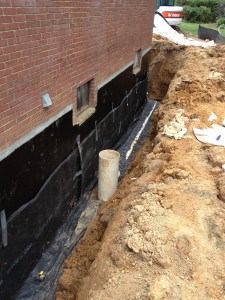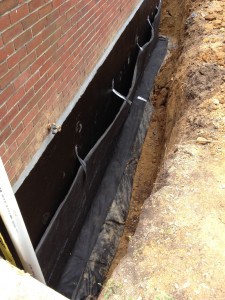It’s wintertime now and it’s important to dress properly so that you can protect yourself from the elements. It may seem like a strange connection, but dressing appropriately for the cold reminded me of the principles that are applied when dealing with foundation waterproofing. Let me explain…
Protecting a foundation is a process completed in layers. Homes that are built today are equipped with substantially more layers than homes from 20 or 30 years ago. Compared to the homes of 60+ years ago (when basements were not designed to be living spaces) modern foundations look like armored tanks next to a Schwinn bicycle. Today, there  are at least five layers of protection used to protect a home, each designed to keep water away from your interior space; these are standard to all new construction. When I engage in a water remediation situation (an existing home with a water problem), it is possible that the recommendation might include up to 9 layers of protection.
are at least five layers of protection used to protect a home, each designed to keep water away from your interior space; these are standard to all new construction. When I engage in a water remediation situation (an existing home with a water problem), it is possible that the recommendation might include up to 9 layers of protection.
Each water remediation situation is different, each calls for certain layers of protection and deciding which layers you need is very similar to the way that you decide what to wear before you leave the house in the morning. Think about your decision making process when you pick out your clothing… if it’s 90 degrees you might get by with shorts, a tee shirt and flip flops. If it’s sunny you add sunglasses or a hat. If there happens to be a chance of rain you might ditch the flip flops for close-toed shoes… you might even take an umbrella. If it might go down into the 60’s you could take a wind-breaker or a coat… I think you see my point; each situation is different and each requires a different article of clothing.
So, here are the layers of protection that your foundation could need:
Solid Foundation Wall – This may sound obvious, but you have no idea how many foundations have cracks or pipe penetrations (for utilities) that allow water easy access to the interior space.
Cementitious Parge – If your home or addition was constructed with block, that block is porous. Cement is porous too, but it provides much more protection than standard block.
 Waterproofing Membrane – This is a black, tar-like, substance that goes on top of the walls and is completely resistant to water penetration.
Waterproofing Membrane – This is a black, tar-like, substance that goes on top of the walls and is completely resistant to water penetration.
Interior Draintile – This is a perforated pipe surrounded by gravel that provides a space for water to sit if it ends up under the basement floor.
Sump Crock and Pump – A sump crock collects water that finds its way into the interior draintile; a sump pump ejects the water from the basement to the ground outside the home.
Exterior Draintile – This is the same concept as the interior draintile (provides capacity for water storage), only on the outside of the foundation.
Drainage Board/Protection Board – Protection board is placed on the exterior foundation wall and protects the waterproofing membrane from rocks or roots that might puncture the finish. Drainboard does the same thing, except is has a plastic webbing that allows water along the foundation to quickly find it’s way to the exterior draintile.
Surface Drainage – Surface drainage is a broad term, but it is anything that is designed to move runoff away from the house quickly, thereby reducing the amount of water that actually finds it’s way to a foundation wall. It could be as simple as positive grading or as involve as yard drains and downspout extensions.
D & A Well and Exterior Sump Pump – A D & A well uses the same concept as the interior Sump Crock and Pump, only it is placed on the outside of the house. This is a technic that was perfected by our own Dave Dunlevy and is used only in extreme cases. It allows any water that reaches the foundation to be captured and relocated before it can penetrate beyond the exterior walls of a foundation.
So bundle up out there, you don’t want your basement to be underdressed if bad weather strikes!